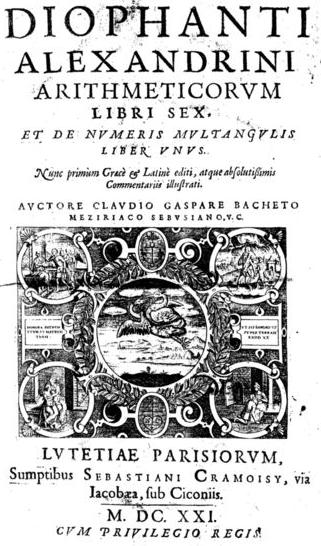
Greek mathematician; worked c. 250 AD (Alexandria)
Nothing is known about the life of Diophantus except an arithmetic riddle, which when solved claims that he married at 33 and had a son who died at age 42, four years before his own death at 84.
The name of Diophantus is associated with the work Arithmetica, which is believed to have consisted of 13 books. Parts of it survive in several copies, but none of it has more than 6 books, and Arabic translations also do not go beyond the 6 known books of the Greek version.
Diophantus' position as a mathematician is unique in Greek science since he addresses problems of algebra that are hard to handle in the Greek absolute-value number notation. For a while he was seen as a representative of a unique Greek development. It is now known that Babylonian mathematicians made great advances in algebraic problems, using their position-value notation, and that Diophantus drew on traditions known to Greek mathematicians but rarely exploited.
The Arithmetica handles equations between various unknowns through problems in which the desired solutions have to be squares, cubes or other geometrically interpretable combinations. While this shows the influence of Greek geometry, Diophantus was the first Greek mathematician to introduce symbols for unknowns. This allowed him to formulate general results, such as "If 2n+ 1 is to be the sum of two squares, n must not be odd."
Diophantus' was the first and only European mathematician to use symbolic notation before it came into general use in the 15th century. His groundbreaking work was not taken up by later mathematicians. Later commentaries on his writing exist, but they do not use symbolic notation any more. An Arab translation from the 9th-century by Qusta ibn Luqa appears to be based on the commentaries, as it, too, does not use symbolic notation.
Diophantus had a significant influence on modern mathematics. Arabic mathematicians such as al-Karaji (c. 980-1030) followed his methods. Pierre de Fermat (1601-1665), the founder of modern number theory, studied his works closely; his copy of Arithmetica contains various remarks in the margins, including new solutions, corrections, and generalizations of Diophantus's methods. Fermat's last theorem, which he conjectured as a result of his studies of Diophantus, occupied mathematicians for generations to come and has only been solved towars the end of the 20the century.
A particular class of equations that involves only addition, multiplication, or taking powers in which all the constants are natural numbers or their negatives and the only solutions of interest are natural numbers or their negatives, is known today as Diophantine equations. Diophantus gave examples of such equations, but the systematic method of solution was not known until the 7th century, when it was discovered by Indian mathematicians.
The 1621 edition of book six of Diophantus' Arithmetica in Latin translation by Claude Gaspard Bachet de Méziriac:

Image: public domain (Wikipedia)